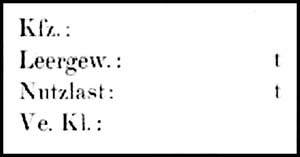|
|
To use the limited transport capacity of the Reichsbahn in an optimal way, loading classes were created. Which vehicles to which loading class belonged was regulated in H.V.Bl. 1941, Teil B Nr. 310. The classification took place according to the weight and the size of the vehicle. The classifications of the loading classes are evident from the table below:
|
|
|
|
With A.H.M. 1943, Blatt 9 from 7th April 1943, Nr. 318, it was dictated that all vehicles had to be labelled with their loading class. This became necessary because often problems with the optimally use of the loading capacity of the Reichsbahn occurred. In the Ht.V.Bl. 1943, 6. Ausg. from 15th July 1943, No. 151, these indications were further specified.
Horse drawn vehicles were always labelled on the left vehicle side. Only guns were labelled on the right side of the gun carriage. The labelling was made in black with 40 mm high letters. The loading class should be placed below the vehicle designation, for example:
Gf. Wg.: (Hf. 1)
Ve. Kl. II.
The labelling on motor vehicles should have additional information. Besides the loading class (e.g. Ib), the designation of the motor vehicle (e.g. Kfz. 15, m. gl. Lkw. (o) or Kfz. 15 (Beh.)) as well as the dead weight and the payload of the vehicle should be listed. The exact Kfz. designation should be stated to prevent errors in inventory and requirement reports in future. Generally, the labelling should be done in the following way (image from A.H.M. Nr. 318, 1943):
 |
Towing vehicles (Zgkw.) should receive an indication for the towing capacity (Anhängelast: ….t) instead of or additional to the payload. For armoured vehicles and tanks, the payload and dead weight should be replaced by the total combat weight. Commercial vehicles should receive the annex (o) for commercial (e.g. le. Pkw. (o)). Commercial vehicles in the place of special military vehicles got the annex (Beh.) for Behelf – makeshift – (e.g. Kfz. 15 (Beh.) for a commercial vehicle in the place of a military Kfz. 15). Motorcycles should not receive a marking for the loading class because of their small size. It was forbidden to apply Kfz. designations which were classified as secret.
The labelling should be made with 20 mm high black letters. The border should be 10 mm thick. On all vehicles with doors, the loading classes were applied to the first door on the left side. All other vehicles should receive these markings on a good visible place on the left side of the vehicle.
|
|